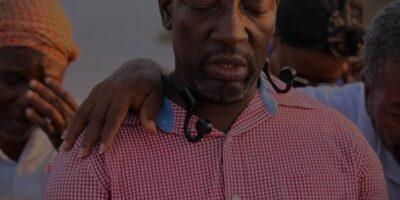Haiti’s health care system is in deep crisis. Recent reports indicate that the Haitian government only finances 7% its total cost. This system is highly dependent on foreign contributions, with foreign aid financing upwards 64% of its total cost. The remaining 29% is placed as a burden on the Haitian household, while formal care is only available to fewer than 42% of the population. This broken system represent 10% of our GDP, which is approximately $715 million USD.
Evaluating markers such as maternal-mortality ratio, infant mortality, life expectancy, fertility rate, sanitation, and access to clean water, makes it easier to comprehend the degree to which Haiti’s healthcare system is failing its people.
Maternal-mortality ratio
Maternal mortality ratio is defined as the number of women who die during pregnancy and childbirth, per 100,000 live births. The maternal mortality ratio in Haiti is 380, which means that out of 100,000 live births, 380 Haitian women died of pregnancy-related causes (see table 1 below, for comparison with others in the region). Many women, especially in rural communities, are forced to give birth at home, due to lack of access to obstetrics and antenatal care. Childbirth is therefore left in the hands of the women themselves, family members, or unskilled helpers (sage-femmes), portending to Haiti’s high maternal-mortality ratio.
To the credit of the government, Haiti’s Health Ministry, with the support of Pan American Health Organization (WHO/PAHO), the Canadian International Development Agency (CIDA), and the European Commission started a “free obstetric care project, which pays health facilities and hospitals to offer poor women free childbirth and care before and after birth, and refunds transport costs”. A good effort but this program is limited to few urban areas and would required expansion in order to have any significant effects.
Perhaps, elected officials in the Haitian parliament should introduce legislation to allocate more money to extend the above program and more importantly in the long term introduce legislation that make maternity care free for all poor families in Haiti.
In addition, investments in some cost effective programs in rural areas where clinics, hospitals or obstetrics care are not readily available could be rewarding in the short term. For example, the Health Ministry can provide appropriate trainings to the sage-femmes that usually deliver babies in those rural places; while in the long term create a comprehensive midwife program with goal of reducing the maternal mortality.
Infant Mortality rate
The infant mortality rate is defined as the number of infants who die before reaching one year of age, per 1,000 live births in a given year. The latest rate for Haiti is 57, meaning for each 1000 live births, 57 Haitian children will die due to lack of access to basic health care services (see table 1 below). What’s even more alarming is that the risk of death between birth and age five is one in twelve children, the highest in the western hemisphere. As disconcerting as these numbers are, they were worst 15 years ago! Advances in recent years with the vaccination campaign in 2007, a concerted effort by the government and UNICEF, contributed to the effective decrease in childhood mortality in Haiti.
Expansion of the vaccination program should be implemented to provide mandatory coverage for all Haitian children. In addition, malnutrition continues to be one of the highest contributors to childhood mortality in Haiti (malnutrition in children under 5 years old is about 12% in Haiti); a thorough nutrition initiative that provides free nutritious foods to all children of poor families younger than 7 years old is needed. Finally, the introduction of sweeping legislation to provide funds to pay healthcare facilities and/or hospitals that would offer full coverage to all children younger than 13 years old, would further consolidate efforts to decrease childhood mortality.
Life expectancy
Life expectancy at birth, defined as the average number of years to be lived by a group of people born in the same year, if mortality at each age remains constant in the future. Also, a marker of quality of life, the life expectancy in Haiti is 63, the worst in the western hemisphere (see table 1 below).
Advances made in Haiti in infectious disease has aided in decreases in mortality as it relates to such diseases as tuberculosis and HIV/AIDS. As a result of these advances, life expectancy in Haiti has increased by 10 years in the last two decades. This progress however may appear marginal when compared to similar medical advances in other countries in the region. One reason for the slow progress despite the success seen with communicable diseases is the fact that non-communicable diseases (chronic diseases, such as high blood pressure, diabetes) have been completely overlooked by the government and the multitude of NGOs operating in Haiti. In fact, according to the latest World Health Organization (WHO) data published in April 2011, stroke, a complication of poorly controlled high blood pressure, is one of the number one killers in Haiti, accounting for more than 10% of total deaths. Hypertension and diabetes are part of the top 5 causes of death in Haiti. Hence, it is necessary to build a high quality primary care network to address the rising problem of non-communicable diseases.
Fertility rate
Fertility rate is defined as the number of children that would be born to a woman if she were to live to the end of her childbearing years and bear children. Haiti has a fertility crisis, with a fertility rate of about 3.6 (see table 1 below). If the current trend were to continue, the Haitian population is expected to reach about 16 million in 2050. In addition, the unmet need for contraception, which is the percentage of married women of reproductive age who do not want to become pregnant but are not using contraception, is about 35%, and it is more than 45% among the poor in rural communities. Resolving this fertility crisis requires an effective family planning program by creating strong reproductive health services in hospitals and clinics throughout the country.
Sanitation and access to clean water
Sanitation and access to clean water represent one of the major hurdles in the health of the population. Access to improved sanitation facilities is only 24% (see table 1 below). It is not enough to have small water projects; the need exists for a complete state-run overhaul of the current infrastructure for clean water and sanitation.
.
Table 1 – Comparing Haiti’s healthcare markers with other countries in the Caribbean
| Maternity mortality per 100,000 live births | Infant mortality per 1,000 live births | Life expectancy (age) | Fertility rate | Access to improved sanitation (%) | |
| Haiti | 380 | 57 | 63 | 3.6 | 24 |
| Dominican Republic | 100 | 23 | 73 | 2.5 | 82 |
| Jamaica | 80 | 14 | 73 | 2.3 | 80 |
| Trinidad | 84 | 18 | 70 | 1.8 | 92 |
| Cuba | 80 | 4 | 79 | 1.5 | 93 |
.
It has been the objective of this article to, not only highlights the ways in which Haiti’s healthcare system is in crisis, but also to provide some suggestions for reform. Broad policy initiatives such as, [a high quality primary care network, a strong public health system, creating and sustaining a local biomedical research infrastructure, a redesign medical education with greater emphasis on family medicine, creation of allied health programs, creating a sound monitoring and surveillance system, and better allocation of resources]; are needed to mend the failed health care system in Haiti.
.
.
References:
1- Carlin Michel, Le gouvernement ne participe qu’à 7% dans les dépenses totales en santé en Haïti. Le Nouvelliste, 8/4/14
2- World Bank Data, Indicators, 2012
3- Word Health Organisation, Free obstetrics care in Haiti, April 2012
4- Institut Haitien de statistique et d’information, Objectifs du millenaire pour le developpement, etat, tendances et perspectives, December 2009
5- Meghan Pierce, The present state of Haitian fertility and the International response, the western hemisphere working group, May 2013







Comments